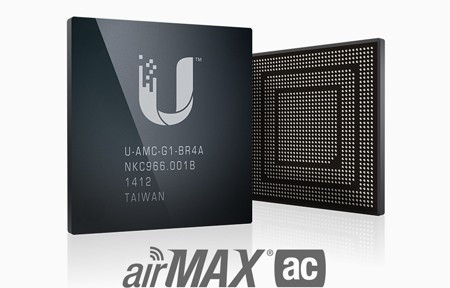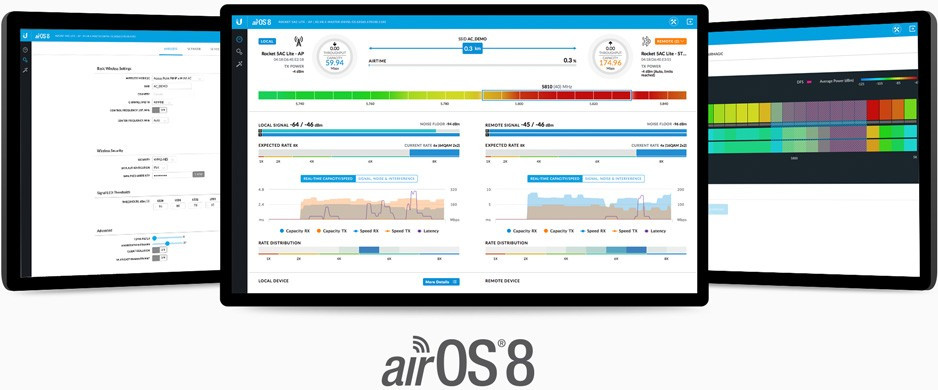5 GHz, 25 dBi bridge with 150+ Mbps throughput and 25+ km link range
The airMAX PowerBeam M5 400, bearing the model manufacture part number PBE-M5-400, is a cornerstone of Ubiquiti Networks' airMAX product line, engineered to provide an exceptional wireless broadband solution. Tailored for point-to-point (PtP) and point-to-multipoint (PtMP) applications, this device operates within the 5 GHz frequency band, utilizing Ubiquiti's proprietary airMAX technology to deliver unparalleled connectivity over long distances with minimal interference.
The PowerBeam M5 400 operates in the 5 GHz frequency band and is fully compatible with other airMAX devices that also utilize this band. This ensures efficient coordination in point-to-point (PtP) and point-to-multipoint (PtMP) configurations, making it ideal for creating cohesive and high-performance wireless networks. Also, please keep in mind that the PowerBeam M5 400 is an airMAX series device, integration with Ubiquiti's UniFi series, which is tailored towards managed indoor Wi-Fi networks and uses a different management system (UniFi Controller), is not direct. UniFi and airMAX devices are designed for different types of network applications, and their operational integration requires careful planning and possibly separate network segments.

Ubiquiti's advanced airMAX technology underpins the operation of the PowerBeam M5 400. It employs a Time Division Multiple Access (TDMA) protocol, which optimizes the allocation of communication time slots among network devices. This method reduces latency, increases network scalability, and allows for more efficient bandwidth usage. Furthermore, airMAX technology incorporates intelligent Quality of Service (QoS) mechanisms, prioritizing bandwidth for critical applications such as voice and video, ensuring smooth and reliable transmission even in bandwidth-intensive scenarios.

At the core of the PowerBeam M5 400's design is its integrated 25 dBi high-gain, directional antenna with a 400 mm diameter dish. Based on it's form factor this model features the highest gain for its size. Additionally, this antenna focuses the radio signal into a narrow beam, greatly enhancing the device's ability to transmit and receive data across extensive distances. The precise beamwidth minimizes off-axis noise, significantly improving signal quality and network reliability, especially in areas crowded with RF signals. Also, Ubiquiti’s InnerFeed® technology integrates the radio into the feedhorn of an antenna, so there is no need for cables to connect the radio to the antenna. This improves performance because it eliminates cable losses.
The PowerBeam M5 400's construction is thoughtfully designed for durability and ease of installation. It features a rugged, weather-resistant enclosure that shields the device from the elements, guaranteeing dependable performance in diverse environmental conditions. A protective radome further enhances durability by reducing exposure to wind, rain, and sun. The device includes a versatile mounting bracket, facilitating straightforward alignment and secure installation on poles or masts, thereby expediting deployment and optimizing signal reception. This PowerBeam™ requires no tools for assembly; only a single wrench is required for pole-mounting.
Security features within the PowerBeam M5 400 are robust, with support for WPA2 encryption to protect network communications against unauthorized access. This level of security is crucial for maintaining the integrity and confidentiality of data transmitted across the wireless network, ensuring that sensitive information remains protected.
Management and configuration of the PowerBeam M5 400 are streamlined through Ubiquiti's airOS interface, a comprehensive and user-friendly web-based platform. airOS offers an extensive suite of tools for network setup, monitoring, and optimization, including real-time analytics, RF diagnostics, and device management capabilities. This ensures network administrators can fine-tune the wireless network for maximum performance and reliability.
Choosing the right PowerBeam
Selecting the right PowerBeam product from Ubiquiti for your network involves a nuanced understanding of your specific needs and environmental conditions. Consider the frequency band: 2.4 GHz models like the PBE-2AC-400 and PBE-M2-400 are adept at penetrating obstacles and are suitable for medium-range deployments, while 5 GHz models, including PBE-5AC-Gen2, PBE-5AC-500, PBE-5AC-620, and PBE-5AC-ISO-Gen2, offer higher throughput and are ideal for clearer, longer-range links. The choice between these depends on the balance between range, throughput, and environmental factors such as different urban / natural obstacles and interference.
Antenna size directly influences range and signal focus: larger dishes on the PBE-5AC-500 and PBE-5AC-620 support the longest distances, whereas the PBE-5AC-Gen2 provides versatile deployment options. The PBE-5AC-ISO-Gen2's enhanced noise isolation makes it perfect for high-interference environments. Lastly, deployment scenarios—whether seeking broad coverage for multiple locations or a focused beam for direct point-to-point links—will guide your selection. Budget considerations and future scalability also play crucial roles in determining the most cost-effective and performance-optimized choice for your wireless network infrastructure.
Compare with similar products
| | | | |
|---|
| Wireless Standard | |
| |
| 802.11a/n
| 802.11a/n
| 802.11a/n
|
| 2.4GHz Radio Rate | |
| |
|
| 150 Mbps
|
| 5GHz Radio Rate | |
| |
| 300 Mbps
| 300 Mbps
|
|
| Wireless Antenna Frequency Range & Gain | |
| |
| 5.150 - 5.875 (GHz) 25 (dBi)
| 5.150 - 5.875 (GHz) 25 (dBi)
| 2.405 - 2.475 (GHz) 18 (dBi)
|
| Antenna range | |
| |
| 25 km
| 25 km
| 20 km
|
| Ethernet Ports | |
| |
| 1 x 1 Gbps
| 1 x 1 Gbps
| 1 x 100 Mbps
|
| Chipset | |
| |
| Atheros MIPS 74Kc, 560 MHz
| Atheros MIPS 74Kc, 560 MHz
| Atheros MIPS 74Kc, 560 MHz
|
| RAM | |
| |
| 64 MB
| 64 MB
| 64 MB
|
| Storage Memory | |
| |
| 8 MB
| 8 MB
| 8 MB
|
| Max Power Consumption | |
| |
| 8 W
| 8 W
| 6 W
|
| Weight | |
| |
| 1.75 kg
| 3.22 kg
| 1.8 kg
|
| | | | |
|---|
| Wireless Standard | 802.11a/n
| 802.11a/n
| 802.11a/n
|
| 2.4GHz Radio Rate |
|
| 150 Mbps
|
| 5GHz Radio Rate | 300 Mbps
| 300 Mbps
|
|
| Wireless Antenna Frequency Range & Gain | 5.150 - 5.875 (GHz) 25 (dBi)
| 5.150 - 5.875 (GHz) 25 (dBi)
| 2.405 - 2.475 (GHz) 18 (dBi)
|
| Antenna range | 25 km
| 25 km
| 20 km
|
| Ethernet Ports | 1 x 1 Gbps
| 1 x 1 Gbps
| 1 x 100 Mbps
|
| Chipset | Atheros MIPS 74Kc, 560 MHz
| Atheros MIPS 74Kc, 560 MHz
| Atheros MIPS 74Kc, 560 MHz
|
| RAM | 64 MB
| 64 MB
| 64 MB
|
| Storage Memory | 8 MB
| 8 MB
| 8 MB
|
| Max Power Consumption | 8 W
| 8 W
| 6 W
|
| Weight | 1.75 kg
| 3.22 kg
| 1.8 kg
|
Technical Specs / Datasheet




Reviews and ratings
Product rating